- Hey what's the story
with the ladder above the entrance to the Holy
Sepulcher Church?
A Participant on every tour, from
Anywhere, as we stand in the courtyard of the
church in Jerusalem
|
The ladder which
stands above the entrance to the Holy Sepulcher
Church in Jerusalem epitomizes the rivalries between
major Christian denominations struggling to exert
their power, prestige and position within the sacred
church.
As a British administrator stationed in Jerusalem,
LGA Cust, wrote in 1929, "The history of the Holy
Places is one long story of bitter animosities and
contentions, in which outside influences take part
in an increasing degree, until the scenes of our
Lord's life on earth becomes a political
shuttlecock, and eventually the cause of
international conflict." |
|
|
|
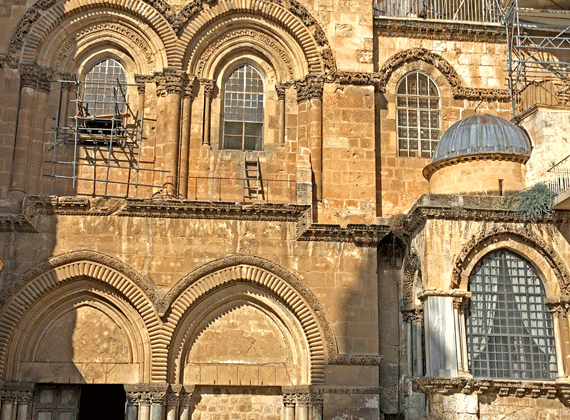 |
|
Photo: Gila
Yudkin in 2020 |
|
The ladder (center) on the facade
of the Holy Sepulcher Church in Jerusalem |
|
|
|
The ladder, standing on a "Greek Orthodox cornice"
above the entrance to the Church of the Holy
Sepulcher leans against a second storey window
belonging to the Armenians. The wooden ladder
(or an earlier incarnation of the present one) can
be seen in all paintings and photos of the church
façade since 1728. Some say it's made of cedar
of Lebanon, the same majestic wood imported by King
Solomon for the building of The First Temple. |
|
|
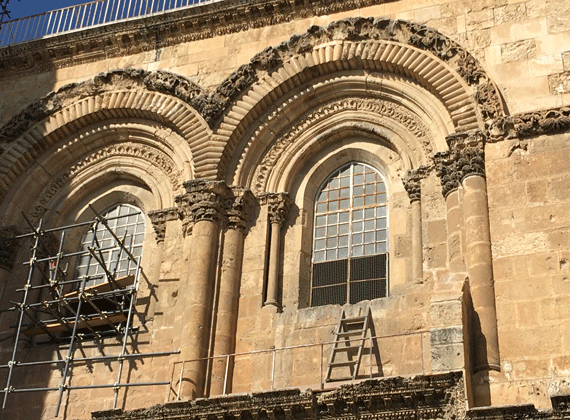 |
|
Photo: Gila
Yudkin in 2020 |
|
The ladder leans against the wall
of the Armenian Chapel of St John |
|
|
|
The Muslim Turks who ruled Jerusalem for four
centuries (1517 to 1917) were flummoxed by the
disputes arising out of the fact that the Christian
Holy Places in Jerusalem and Bethlehem were not
"owned" and managed by just one community, but were
shared and served by several. The major
players were the Greek Orthodox, the Roman Catholics
and the Armenians. The minor players were the
Copts, Ethiopians, and Syrians. |
|
|
|
The inter-denominational squabbles over chapels,
prayer niches, walls, corridors and sometimes even
nails led to frequent fist fights, brawls, black
eyes and perhaps an occasional broken jaw. |
|
|
|
In an attempt to lower the temperature within the
contested holy places, the Turks drew up a document
(firman in Turkish) regulating possession,
usage and liturgy of each of the denominations party
to the disputes. This document known as the "Status
Quo in the Holy Places" was first imposed in
1757 and reaffirmed in 1852. It is still in
effect! |
|
|
|
Thus, according to the firman, in order to
move or remove the ladder, it would be necessary for
all three denominations – the Greek Orthodox,
Armenians and Roman Catholics to agree. (A highly
unlikely scenario!!). |
|
|
|
The earliest record of this ladder is a 1728
engraving by a Franciscan monk living in Jerusalem
named Elzearius Horn. (If you look carefully
at the engraving, you will note the dark shadow of a
ladder leaning into the right-hand window above the
blocked-up right entrance to the church.) The
window, ladder and ledge all belong to the
Armenians. However, the cornice supporting the
ladder belongs to the Greek Orthodox. |
|
|
|
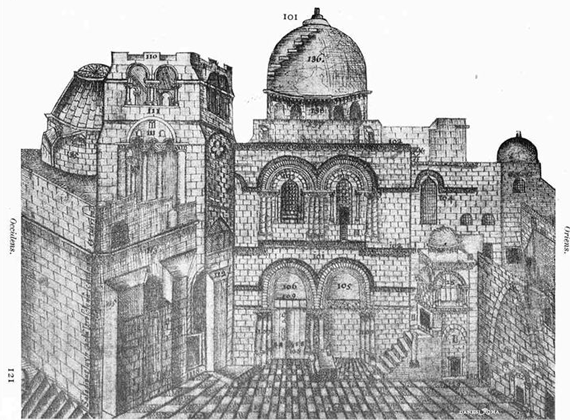 |
|
Photo of the
Elzearius Horn 1728 engraving in the public
domain |
|
Note the ladder on the second
storey window of the Holy Sepulcher Church |
|
|
|
A century later, the prolific Scottish painter David
Roberts records the ladder as well. The cover page
of his lithograph album of his sketches of the Holy
Land published in 1842 clearly shows the ladder
standing on the window ledge, the same way it is
seen today. |
|
|
|
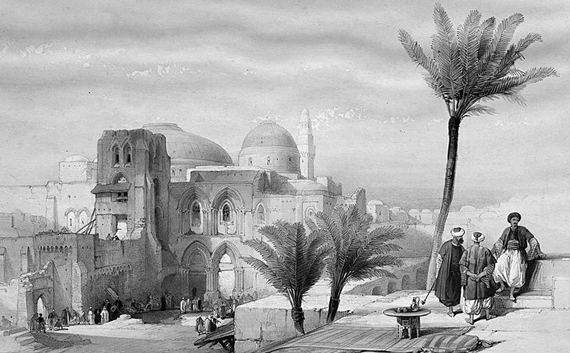 |
|
Lithograph in the
public domain |
|
Sketch of the Holy Sepulcher by
David Roberts published 1842 |
|
|
 |
|
Lithograph in the
public domain |
|
David Roberts' sketch clearly shows the ladder in place before 1842 |
|
|
|
Legend has it that the ladder was first introduced
sometime in the 18th century when the Ottoman Turks
taxed Christian clergy every time they entered and
left the Holy Sepulcher Church. The clergy who
served the church set up living quarters within the
church to avoid paying the tax. The ladder was
then placed on the balcony to allow the "locked-up"
Armenian monks to get fresh air, drink coffee and
grow vegetables. |
|
|
|
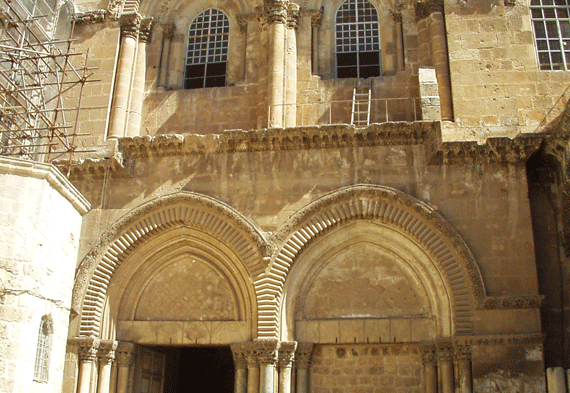 |
|
Photo: Gila
Yudkin in 2003 |
|
Imagine drinking coffee on the
balcony created by the Greek Orthodox cornice |
|
|
|
The Armenians claim that the Turkish sultan was
distraught by the constant clashes between the
Armenians, Greek Orthodox and Roman Catholics.
He ordered that the church doors remain closed and
the priests locked up inside until they agreed to
settle their differences. |
|
|
|
During the three months the church was closed, the
Armenian priests brought in a ladder and a rope was
used to haul food and supplies up into the church.
At the end of the three months an agreement was
reached among the three denominations, but the
Status Quo in the Holy Places edict had already
been issued. So the ladder remained in place. |
|
|
|
Over my 40-year career as a guide, I have brought
tens of thousands of pilgrims to the courtyard.
The ladder has always been there, rain or shine,
winking at us, as a kind of conversation piece. |
|
|
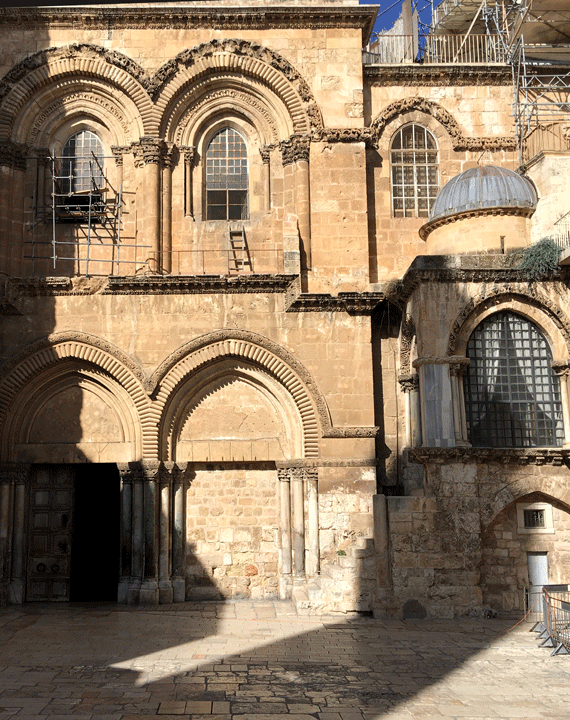 |
|
Photo: Gila
Yudkin in December 2020 |
|
The courtyard of the Holy Sepulcher Church during
the 2020 Covid 19 Pandemic |
|
|
|
As I write this during the height of the Covid 19
crisis, with the church not shuttered, yet empty of
pilgrims, the ladder stands in place as it has for
nearly three centuries. When you can, I
invite you to come to Jerusalem to see for yourself. |
|
|
|
And then we'll discuss, "Does the Status Quo
Agreement provide a reasonable solution for the
complex issue of sharing a sacred space????" |
|
|
|
Copyright December 2020 Gila Yudkin. Permission
needed for any reuse. |
|
|
|
Postscript |
|
|
|
After uploading this page, I chatted with my friend
and colleague Yossi Granit about my research on the
ladder. To my utter surprise, he told me that
while attending a seminar for guides at the Holy
Sepulcher Church in October 2015, he and the other
guides noticed that
the "immovable" ladder had been moved -- to the left
window. And he even showed me a photo to my
astonishment. Here it is: |
|
|
|
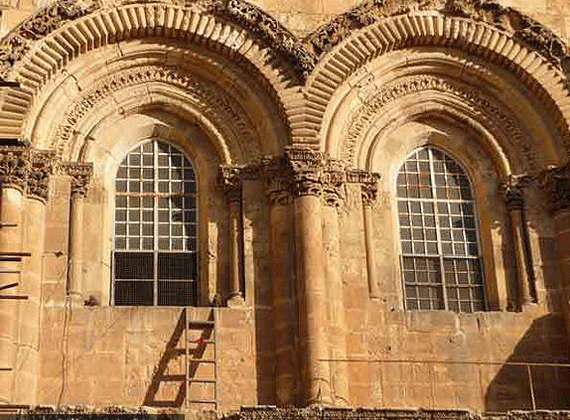 |
|
Photo courtesy of
Yossi Granit |
|
In 2015 the "immovable" ladder was
moved from the right window to the left! |
|
|
|
All I can is that as of the end of 2020 the ladder
representing the rivalries within the Holy Sepulcher
Church is still in its traditional place -- by the
right window.... Gila |
|
|
|
See photos taken by Gila in July 2020 when the
Church of the Holy Sepulcher reopened
after the first wave of the Covid 19 pandemic. |
|
|
|
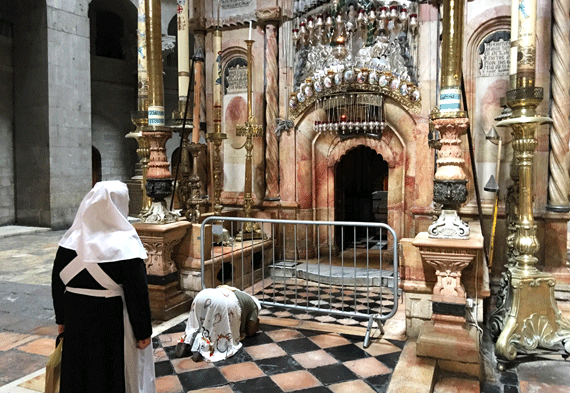 |
|
Photo: Gila
Yudkin in July 2020 |
|
The sisters are facing the
Aedicule (the Tomb) inside the church, Station 14 |
|

